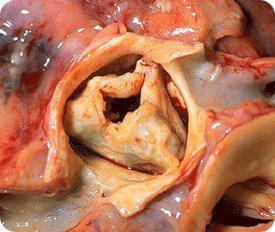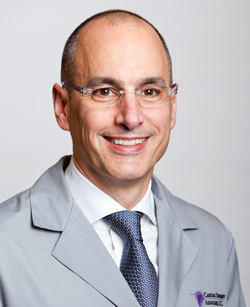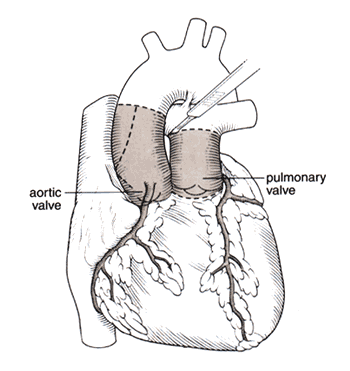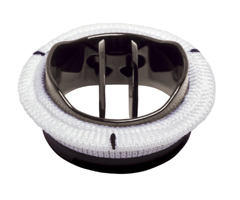“Can Aortic Valve Stenosis Be Cured Through Nutrition?” Asks Paul
By Adam Pick on February 26, 2011
I recently received an interesting question from Paul about aortic stenosis and nutrition. Paul writes, “Hi Adam – I’m in my 40’s and just diagnosed with a severely leaking valve. I was told I need a mechanical valve or I will drop dead in 2 to 3 years. I do not want to take Coumadin. Is it possible for patients to enter a natural program — via a qualified nutritionalist — which may actually stimulate tissue growth around the valve, thus fixing the cause rather than treating the symptoms?”

Aortic Valve Stenosis – Narrowing Heart Valve
While I have my own thoughts on this topic, I wanted to get an expert opinion for Paul. That said, I contacted Dr. Marc Gerdisch, MD, chief of cardiothoracic surgery at St. Francis Heart Center in Indiana. As many of you know, Dr. Gerdisch is a specialist for valvular treatment and cardiac tissue repair.

Dr. Marc Gerdisch – St. Francis Heart Center
In his response to Paul, Dr. Gerdisch made several interesting points that I wanted to relay to our patient and caregiver community. First, Dr. Gerdisch discussed Paul’s diagnosis:
In order to fully answer your question, I would need to more completely understand the changes that have occurred for your aortic valve. Given your young age, you most likely have a bicuspid valve (you were born with a two leaflet valve instead of the usual three). This is surprisingly common, occurring in between 1 and 2 percent of the population and being approximately twice as common in men as women. You mention that you have been diagnosed with a severe leak and go on to talk about aortic stenosis. A leaking valve is referred to as regurgitant and an obstructed valve is called stenosed. You may well have both conditions, but they can occur separately as well.
Specific to Paul’s questions about nutrition as a remedy to aortic stenosis, Dr. Gerdisch noted:
With respect to your question about nutrition, what we eat plays some role in every function of our body. That said, there is no evidence that it can change the course of valve disease.

Ross Procedure Diagram
Then, Dr. Gerdisch discussed various heart valve procedures available to Paul:
When choosing an operation, multiple questions need to be answered by both the patient and the surgeon. You are very concerned about the use of warfarin (Coumadin). We are able to repair or spare some bicuspid valves. In which case, the potential for another operation is weighed against the benefit of retaining your own tissue. Similarly, the Ross procedure can be performed, moving the patient’s pulmonary valve to the aortic position and replacing the pulmonary valve with a cadaver valve. This is an option for some young people but again, the risks of re-operation must be considered. Recently, we have been constructing “bio-roots” which are a composite of a tissue valve and a Dacron graft (a synthetic man-made material) used to replace the first portion of the aorta. Reoperation for these patients may be less challenging. The valve is seated in the Dacron graft just above the annulus (where the patient’s aortic valve leaflets attach).

On-X Mechanical Heart Valve
Finally, Dr. Gerdisch addressed Coumadin, the On-X mechanical valve and new types of anticoagulants:
Indeed, warfarin is a concern, but you should also realize that the largest studies indicate a survival benefit for younger patients receiving mechanical valves. This does not mean that a mechanical valve is the best option for all younger patients. It just means that you need to be fully aware of the data as it exists. Furthermore, we are heading into a shift in anticoagulation management for mechanical valves. We are currently participating in an FDA trial for the On-X mechanical valve with half of the patients being randomized to taking only aspirin and Plavix. In addition, new anticoagulation medications are becoming available, that do not have the dietary restrictions or monitoring requirements of warfarin. They are not currently available for prosthetic valve therapy, but I suspect it will not be long.
I hope this helps Paul (and perhaps you) learn a little more about the treatment of aortic valve stenosis. Thanks to Paul for his interesting question. And, a special thanks to Doctor Marc Gerdisch for his insightful response.
Keep on tickin!
Adam
|
Grace Jacobs says on February 27th, 2011 at 12:34 pm |
|
I particularly found Dr. Gerdisch’s reply of interest. I had The only negative in taking Coumadin (if you can call it that and I don’t) is that I am required to take a Pro Time Test (blood test) every 3 to 4 weeks to make sure I am taking the proper dosage. I found that Dr. Gerdisch’s talking about the FDA trial that perhaps aspirin and Plavix will be what may be required in the future and will bring this to my cardiologist’s attention in case he already doesn’t know about this (I am sure he does.) Thank you so much for bringing this to the attention of those that had my kind of surgery and are on Coumadin for life. I nerver fail to read you valuable e-mails. Thank you a million. My best, Grace Jacobs. |
 |
|
W.D.Brown says on February 27th, 2011 at 12:57 pm |
|
2 years and nine months ago on my birth day 2/June/2008 I was given a AORTIC St. Jude Mechanical valve, I was 67 years old but they gave me the Mechanical one so I wouldn’t have to have another operation down the road. It took a while to get use to the monthly INR testing and taking Coumadin but it depends on how bad you want to live a long life. I would recomend this to any one in your condition and age. Live long and Healthy |
 |
|
Shari Shoufler says on February 27th, 2011 at 1:01 pm |
|
Goodafternoon Adam and Paul… Less than 3 weeks ago, I had minimally invasive mitral valve surgery, using the DaVinci Robotic System. Although my condition was congential and had caused me problems in the past (CHF during pregnancy with my daughter), I, too, would have done anything, eaten anything or taken anything to avoid surgery. Paul seems to think (or is being advised) that because of his age he will have no choice but to choose the mechanical valve/coumadin route. I would like to share my decision in the hopes it might help him or other 40somethings like myself feel at ease with their choice. My surgeon, the fabulous Dr. J. Michael Smith here at Cincinnati’s Good Samaritan Hospital, gave me all the information as to my choice of selecting the mechanical valve or tissue porcine/bovine valve. I opted for the tissue valve and here are my reasons why: -Like Paul, I also hated the idea of being on coumadin.I have a TERRIBLE time remembering to take medicines and the risks of being on coumadin at my age (including possible interactions with other medications I might need to take later in life) were too great for me, personally. Paul, I urge you to talk with your surgeon (or several surgeons) as to your surgical options, why he is recommending the mechanical valve and whether or not there is a particular reason he would not feel that, given your age, it wouldn’t be a safe risk for you to take given your adversity to the coumadin. If you watched Barbara Walters recent special, you may note that comic Robin Williams received a bovine aortic valve at the age of 57. Although I am still very sore and numb from the surgical pathway, my surgery was a success and at my 2 week post-op my surgeon deemed my chest x-ray as “near perfect” and my heart beating like a “fine Swiss watch”. I cried all the way to my car. I am already experiencing less shortness of breath and a feeling of confidence in my heart that I haven’t had in years!!! Shari Shoufler, proud to be a heart disease/heart surgery SURVIVOR!! |
 |
|
ALBERTA GRABOWSKI says on February 27th, 2011 at 1:31 pm |
|
NEW TYPES OF ANTICOAGULANTS: WHAT DO YOU OR YOUR RESEARCH THINK ABOUT THIS ? |
 |
|
Rick Pruett - Vegan says on February 27th, 2011 at 3:41 pm |
|
Before learning of my aortic valve bicuspid stenosis (1986), I had been a vegetarian since 1976 and a former cardiovascular surgical assistant (CV Center, Memphis, TN). I can assure him diet will not arrest his valve condition. However, if a “balanced” diet (preferably vegan) that includes the necessary amounts of plant derived protein, is strictly adhered to, Paul can “improve the chances” he will not suffer from coronary artery disease or other common conditions that persist as a result of eating animal derived foods. His heart’s future can be a very healthy one! If the Ross Procedure is a viable option for Paul, I truly hope he will give it serious consideration. In 1986, I had a St. Jude mechanical valve installed and subsequently have been on Coumadin anticoagulation therapy ever since. My valve is functioning perfectly, but I recently learned my ascending aorta has dilated to 5.4 centimeters. This April, Dr. Edward Chen (Emory University-Atlanta) will be replacing my aortic aneurysm with a Dacron graft. He is likely to remove any remaining diseased valve root tissue and reconnect my left and right main coronary arteries. Depending on the measurements of my current valve, he may or may not install a new mechanical valve. If the valve is replaced, I have chosen the On-X. Adam Pick is to be commended on his efforts to bring so much new cardiac surgical knowledge to patients and potential heart valve recipients. Particularly, his recent articles about cardiac matrix procedures and future stem cell use in generating one’s own heart valves, are outstanding. I hope this helps. -Rick Pruett |
 |
|
Michelle says on February 27th, 2011 at 5:04 pm |
|
Hi everybody, has anyone out there heard of having a radiation-“fried” valve and/ or an aortic valve calcified with/from Ankylosing Spondylitis? I sing about ten concerts a year in a terrific chorale. Will the ventilator TUBE hurt my voice? Can you guys sing a note (or talk normally) soon after the surgery? I’m slim, 62, and think I will get a bovine or porcine replacement with a minimally invasive approach. Thanks! |
 |
|
Nancy says on February 27th, 2011 at 9:41 pm |
|
I am celebrating 2.5 years after surgery and am so glad that I chose a bovine aortic valve replacement. I had the full open heart surgery because I had 4 inches of my aorta replaced. Your decision will affect the rest of your life and I believe that technology advances will be tremendous within the next decade. They are already experimenting with transcather replacements of an aortic valve in elderly patients. This will be the new wave of the future – I am betting on it and that is why I chose the bovine valve and have never regretted the decision. |
 |
|
Earl Ledden says on February 28th, 2011 at 6:19 am |
|
For us non mechanical valve guys and gals. there is a new drug. pradaxa, that may be available as a substitute for coumadin. I’m on it and am feeling as normal as ever. One pill twice a day. Adam,this is truly a new approach and will probably replace coumadin in the future. Can you check in to this drug and share your thoughts? Thanks for everything. |
 |
|
Joseph says on February 28th, 2011 at 7:10 am |
|
Dear Nancy, Your commentary is very encouraging for me. I have severe aortic stenosis and I’m a candidate for OHS to replace it. I think I’m going to choose the Caprpentier Bovine ThermaFix valve for myself. Tell me, how do you feel? Or you or where you an athlete? Do you sense a change, a difference in the way you fell and live your life since the surgery. Any answer would be greatly appreciated. Thank you, Joseph in NYC, |
 |
|
Rick Parks says on February 28th, 2011 at 12:08 pm |
|
I choose the On-X and participate in the On-X study, which allows me to test my INR at home on a weekly basis. Not having to go into the doctor every month or so, or more frequent if you INR is not stable, was important. Most importantly was how the On-X had/is performed/performing in poulations where the attending doctors know that the patients are not taking their coumadin. So, I choose the On-x because 1. I didn’t want to replace a bio-valve 7 to 10 years down the road (I was 45 at the time of surgery) 2. I wanted to get into the On-X test population (my goal was to avoid coumadin all together, but I ended up in the control group and take a lower coumadin dose) and 3. I wanted the best mechanical valve should I every find myself in a place where I don’t have access to anti-coagulents like coumadin or aspirin (hiking climbing fishing etc.). The On-X reports to have a great record in South Africa with patients who don’t take thier coumadin–nobody is suggesting that you don’t take your prescribed medication. I just wanted the valve with the best for performance without coumadin and at the time the On-X story was good enough for me. Looking back over the last year and a half I would have gone nuts if I had make monthly or weekly trips to the clinic for INR testing. I had my On-X implanted by Dr. Gosta Pettersen at the Cleveland Clinic in Cleveland. Dr. Dennis Nichols at Tacoma Multi-care is tracking my study results. Rick Parks. |
 |
|
John Dawson says on June 9th, 2013 at 6:16 pm |
|
I am a 63 yr old male. I have chronic Ankylosing Spondylitis starting early twentys. I require surgery for aortic valve replacement. I have little or no movement in my spine, chest or ribs. My worry is the chest surgery and what effect it may have on the A.S.(dormant at present) and what damage may occur in this region. Are there any case histories out there. Thanks J.D |
 |
|
Kala says on February 8th, 2017 at 9:25 am |
|
Dear Doctor, I want to get your opinion and suggestion for my mother’s heart concerns. Please find the brief background on my mother’s heart issue: My mother is 69 years old now and she went thru bypass surgery in 2008 due to a heart attack. She was doing fine so far but complained of breathlessness during last December after which we took her to Narayana Hrudayalaya for checkup and treatment. After the bypass, we were going to the same cardiologist for every year routine check-up and they were observing the aortic measurement going up year over year. In 2008 her measurement of the same aortic valve was 25 only. But over the years it gradually went high and in last October 2016, when we did the echo it showed 55. When she complained in December of breathlessness, we took echo again and it came to 90. That is when doctor told us that this is very high and needs to be operated. During their tests of Echo and Angiogram, they found that she has Severe Aorta Stenosis and needs to be taken thru the Aorta valve replacement surgery. During our meeting with the surgeon, we were given the following points: As she is old and already gone thru open heart once, want to explore if there is any other method I can make this calcification removed or reversed. |
 |
|
Mario Cepeda says on April 5th, 2018 at 7:41 pm |
|
What happened? No reply from the doctor? |
 |












